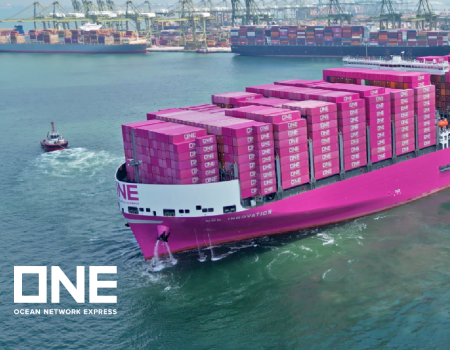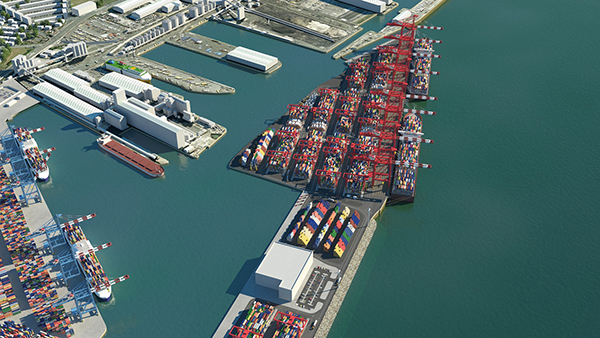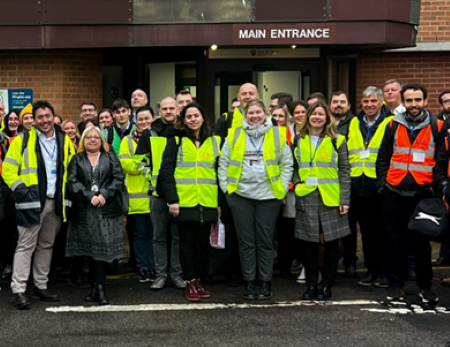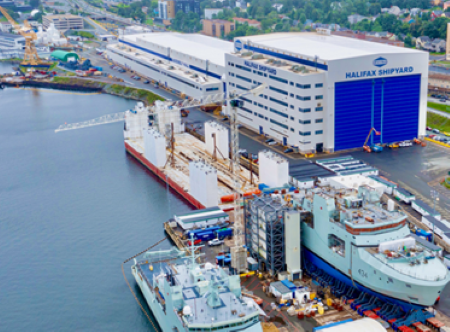Peel Ports is gearing up for the opening of its new £300 million container terminal, Liverpool2, delivering a new world-class hub port for the UK and Irish markets
The Company
Peel Ports is one of the UK’s largest port groups, owning and operating six of the UK and Ireland’s most important ports. It handles 70 million tonnes of cargo every year. It is headquartered in Liverpool and employs around 2,750 staff.
Peel Ports is part of the Peel Group, one of the UK’s leading infrastructure, real estate and investment companies. Its portfolio ranges from airports to energy, and includes flagship sites such MediaCityUK, Manchester’s Trafford Centre and Pinewood Studios.
The Challenge
300 years ago, Liverpool helped to usher in a new era of international shipping and trade, with the creation of the first commercial wet dock, an innovation that saw the city become one of the world’s leading ports.
Liverpool remained at the forefront of the shipping industry well into the 20th century but an evolving competitive environment driven by the advent of containerisation and changing market conditions saw it gradually lose ground to challenger ports.
Industry growth over the past 100 years has seen ever-increasing vessel sizes which the existing Royal Seaforth terminal at the Port of Liverpool is unable to accommodate. Currently the terminal is accessed through a lock and we at Peel Ports recognised that, without decisive action, by 2015 85% of the global container vessel fleet would not fit into the Port of Liverpool.
To regain ground, steps were taken to think beyond the traditional port boundary, envisioning a terminal solution that could accommodate modern container shipping vessels. Any proposed solution had to be able to meet the market requirements for service predictability, reliability and turnaround. Investment in logistics infrastructure and technology solutions were also considered as we have long realised that terminal productivity has a critical impact on supply chains and that port performance is a critical determinant in decision-making.
The Solution
Liverpool2
We have answered these challenges through the delivery of the Liverpool2 project. The centrepiece of this development is a £300m container terminal that will create a new central gateway for international shippers, helping them to take their goods closer to market.
The terminal will provide the port with an additional 1m TEU capacity, help them to deal more effectively with an estimated 26,000 vessel movements annually through the whole port, and deliver ‘best in class’ capabilities to customers.
There are three key elements to the investment. The first, and most prominent, is the infrastructure. As well as the new quay wall Peel Ports have created – reclaiming land from the Mersey – there will be eight giant ship-to-shore (STS) cranes, supported by 22 cantilever rail-mounted gantry cranes. Together, these cranes represent around a third of the overall investment cost. In November 2015, Liverpool2 welcomed the first of the five STS cranes. The super structures are produced by Chinese company Zhenhua Heavy Industries Co (ZPMC) – the largest heavy duty equipment manufacturer in the world. Each crane measures 92 metres high to the top of the frame, approximately the same as Liverpool’s iconic Liver building and 132 metres high when the boom is raised.
The fleet of 22 semi-automated and remote-controlled CRMG cranes have a fifty-tonne capacity and a 13-wide container span. They are single pick and can lift 1 container over six. The STS cranes are twin-pick and can lift up to 10 high on deck. They have a safe working load of 85 tonnes and an outreach of 24 containers. Both are capable of working in wind speeds up to 50mph.
The crane capabilities are underpinned by the second key aspect of our development: technology. The container terminal industry has been generally slow to adopt automation, despite the technologies being advanced, proven and capable of delivering reliable operational efficiency. This summer Peel Ports introduced the Navis N4 Terminal Operating System (TOS) and ‘intelligent’ AutoGates which are now live and fully operational following the construction and commissioning programmes. The new technology supports faster haulier turnaround and container handling and uses state-of-the-art identification technologies to manage gate operations, ensuring that all containers and trucks are automatically identified before entering or exiting the terminal.
This combination of infrastructure and technology will reduce the time taken to transfer containers from port to road or rail, helping the Port of Liverpool to achieve targets of 65% of haulage turned round in 30 minutes and 95% of haulage turned in 60 minutes.
However, such performance is only possible if other aspects of port management are efficient. We have prioritised improving the quality of information that they manage and how this is shared with their customers and clients. Accurate forecasting, real-time exchange and building datasets can make a major difference to the efficiency of operations.
Peel Ports have also taken steps to streamline their structure and create a more flexible workforce that can respond to changes in demand and not just respond to customer needs but to anticipate them.
It is only with the right people, culture and behaviours – managing physical and technological assets – that they will realise the full potential of their operation.
Ocean Gateway & the Northern Powerhouse
Over the next 50 years, The Peel Group’s Ocean Gateway will deliver an unprecedented scale of co-ordinated private sector investment across the North West of England. It is a truly pioneering approach to the renaissance of the strategic corridor encompassing the City Regions of Liverpool and Manchester, and adjacent areas within Cheshire and Warrington.
The idea of joining northern cities is integral to the development. Liverpool2 will continue to serve bilateral trade routes that feed into the North of England which are supported by manufacturing, warehousing and consumer bases in the surrounding area. Creating a northern powerhouse, with truly interconnected cities from east to west, will continue to make the Port of Liverpool the logical choice for customers throughout the world.
Peel Ports are making a significant investment in the future of the logistics infrastructure of the North-east. The Liverpool2 development is complemented by a £125m investment in the national import centre at Port Salford, connected to Liverpool2 by the Manchester Ship Canal.
The major financial commitment by the business to new infrastructure and improved, direct access to the manufacturing, warehousing and consumer bases in the North of England is driven by demographic and geographic shifts. Not only do 65% of the UK and Irish population live within a 150m (240km) radius of Liverpool, but the region is also home to the real ‘golden triangle’ – a concentration of warehousing and distribution facilities, which analysis shows is further North than previously thought. Ultimately, 60% of UK and Irish container traffic is headed for a destination close to Liverpool than South-East ports.
Cargo 200
In addition to their investment in Liverpool2, Peel Ports have unveiled a plan to cut 200 million miles from UK freight transport – the Cargo200 initiative. This initiative aims to save cargo owners up to £400 per container and to remove 200million miles from the UK’s road and rail network over the next five years by recruiting up to 200 cargo owners, importers and exporters to support the campaign and bring about a conscious shift in how the supply chain operates.
Echoing the innovation of 300 years ago, the carbon emission initiative is calling on the UK freight and logistics industry to rethink supply chain and services routes in order to reduce freight mileage by 200 million miles over the next five years.
It also offers cargo owners, importers and exporters the opportunity cut the cost of inland transportation, saving up to £400 per container, by switching current delivery of ocean freight from South-East ports to the centrally located Port of Liverpool, if their goods start or end their journey in the North of the UK.
Peel Ports have already garnered initial support from a number of household-name brands, including Typhoo and B&M.
The Results & The Future
Peel Ports strategy has been to go as far as we can along ‘the curve’ of modern port operations. Liverpool2 has given them an exceptional opportunity to introduce leading-edge technology and infrastructure that will remain fit for their customers’ needs for decades to come. That is not to suggest that they are sitting on their laurels though. They see the scope for improvement in the continued seamless integration of their back-office operations and the overall refinement of their processes going forward.
When complete, Liverpool2 will allow global shippers ‘ship-to-door’ access to the UK’s major import centres via the most economic and lowest carbon route and provide northern UK-based exporters with a more competitive route to market.
Liverpool2 will also bring a once-in-a-generation opportunity for companies to transform their international supply chains. The logistics solution will provide a new, low cost, low carbon, low congestion solution for the UK and Ireland.
The investment in Liverpool2 will strengthen the growing infrastructure of the Northern Powerhouse to create a gateway into the North of the country which Chancellor George Osborne referred to on his recent visit to China, citing the area’s important trading links and outstanding pedigree in food and drink, fashion, automotive and aerospace.
More importantly, Peel Ports, vision as a company is to be very much a supply chain partner, offering port-centric logistics solutions, such as the new warehousing and distribution facility at Port Salford that will provide a better end-to-end solution for the cargo owners that need an efficient route to the heart of the UK marketplace.








